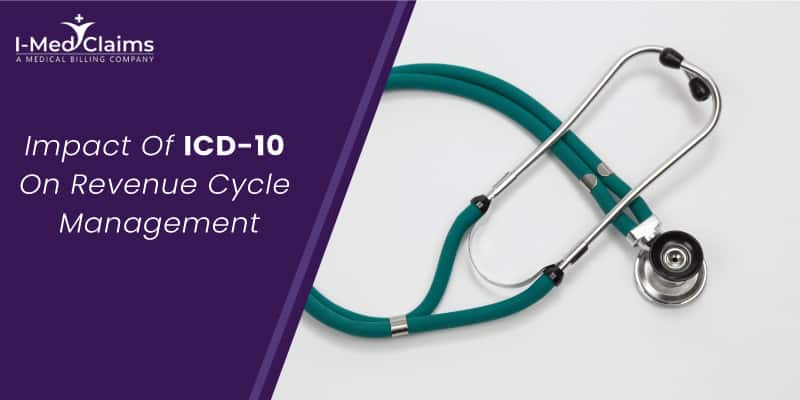The implementation of ICD-10 coding in 2015 resulted in a significant improvement in data quality by increasing specificity to enhance precision in labelling and charting health issues that cause morbidity. While the increased level of detail has enhanced situation tracking and capacity to acquire insurance claims. ICD-9 included 3,824 procedure codes and 14,025 potential diagnoses, whereas ICD-10 includes 71,924 procedure codes and 69,823 diagnoses. The vast expansion has enabled organizations to receive payment for services rendered more clearly and efficiently. Following that, we will look at how the implementation of ICD-10 coding has impacted Revenue Cycle Management.
Here’s a brief list of how ICD-10 coding can affect the RCM process at different phases
This summary is a good starting point for policymakers to evaluate and recognize critical aspects of ICD-10 coding that can improve Discharged Not Final Billed (DNFB).
- Clean bills prevent claim rejection disruptions. There is no need to recycle and rebill the claim if everything is correct the first time. Many third-party payers base payment on DRG (diagnostic-related groups). This system was created to standardize hospital payments for related admissions (Pneumonia, Appendectomy, Stroke, Hip Replacements, etc.). Encoders are available to help locate the appropriate diagnosis, process codes, and select the DRG. They also recognize age/gender edits and improper principal diagnoses and assist with diagnosis and procedure sequencing.
- Scrubbers are billing programs that perform a final check before issuing a bill. They can detect medical necessity problems and abstracting errors (procedure date, surgeon, and disposition). These errors must be reported to coding for adjustment.
- Coding assistance may also be required during the appeal process for claims rejected by third-party payers. Even if the reason is a minor issue that can be easily fixed, there is a potential to let these claims sit and miss opportunities for appeal.
- Retrospective audits are another tool that can help with the revenue cycle process. They specialize in recognizing coding and sequencing mistakes that can lead to over or underpayment. They can educate the coding team and keep updated on quarterly and annual notifications. They can provide reassurance in the face of major coding problems that could lead to the negative third-party payer or regulatory agency deeds (intensified review, fines, and penalties).
Critical Points Of Impact
One significant function that demands attention is Revenue cycle management which includes medical coding, contract management, billing, and reimbursement. Healthcare systems must evaluate whether existing code sets adequately describe the organization’s business guidelines and whether there is an opportunity to utilize more granular capabilities of ICD-10 to obtain process optimization and sufficiently represent the services offered.
Eligibility and utilization management:
Eligibility and utilization management will require the configuration of eligibility terms, as well as updating of medical necessity, policy verifications, and related protocols to use ICD-10 codes.
Clinical documentation:
A comprehensive examination of clinical documentation procedures is required to identify situations where additional data is necessary to allocate the appropriate ICD-10 code. The evaluation findings can be used to direct clinical documentation improvement initiatives. That includes training doctors and other caregivers in paperwork techniques and evaluating documentation layouts in electronic health records. The treatment record enhances care quality, billing and profitability, and clinical and financial audit results by acquiring clinical documentation, including all applicable diagnostic data.
Contract management, billing, and reimbursement:
The transition to ICD-10 will necessitate providers to describe patient conditions in new ways, referring to the latest coding standards, and adhering to new paperwork guidelines for reimbursement purposes. ICD-10 qualifies clinical conditions and processes in many instances differently than ICD-9-CM. As a result, converting complex billing techniques from ICD-9-CM to ICD-10 may have unexpected effects on cumulative payments to providers or payment distribution across providers.
Recognizing how new ICD-10 codes correspond to existing ICD-9 contracts and reimbursement information will be critical for billing and benefit cooperation. The sector is bracing for a rise in denials due to inconsistencies between the two coding structures. Rejections can be caused by various factors, including incorrect eligibility checks or inadequate documentation for handling a claim. To prepare for a spike in denials, providers must analyze the underlying cause of existing contradictions and identify process gaps.
Accuracy in RCM process Improve Claim Approvals and Reimbursements
Developing a successful Revenue Cycle Management procedure will improve your company’s ability to bill successfully and finally receive timely claim payments. ICD-10 is advantageous to organizations because it allows for more fluid and smooth coding. Implementing something as simple as a scrubber can assist inspect bills before they are posted and prevent avoidable mistakes from delaying claim pay-outs. Preventing unscheduled downtime, such as mistakes in the type of procedures performed and services rendered, will relieve some of the stress on encoders and assist the agency’s billing activities in the running smoothly.


